#physics of collisions
Explore tagged Tumblr posts
Text
Inelastic Collisions [Ex. 1]
A 4.98 kg box moves at 2.5 m/s and collides and sticks to a 4.80 kg box moving at -2.5 m/s. What is the velocity of the objects after they collide?
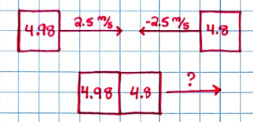
-- Since the objects stick together, you know the collision is inelastic

-- Use conservation of momentum
-- p = mv

-- This can be simplified for inelastic collisions

-- Plug in values and solve for Vf

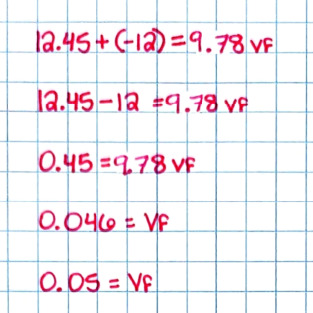
-- The velocity after the collision is 0.05 m/s
.
Patreon
#studyblr#notes#my notes#physics#physics notes#physics vocabulary#physics vocab#science#introductory physics#physics 1#physics 2#physics I#physics II#physics terminology#scientific terminology#physics concepts#concepts in physics#inelastic collisions#collisions#collisions in physics#physics of collisions#velocity#acceleration#speed
1 note
·
View note
Text
Instabilities in Competition
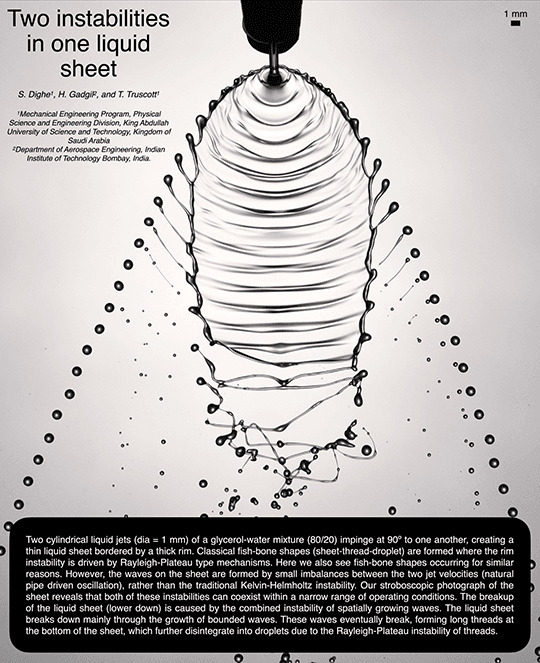
When two liquid jets collide, they form a thin liquid sheet with a thicker rim. That rim breaks into threads and then droplets, forming a well-known fishbone pattern as the Plateau-Rayleigh instability breaks up the flow. (Image credit: S. Dighe et al.) Read the full article
#2024gofm#fishbone#fluid dynamics#fluids as art#instability#jet collision#physics#Plateau-Rayleigh instability#science
89 notes
·
View notes
Text


#cyberpunk 2077#virtual photography#night city streets#environmental shots#console shots#2.2 run#breaching collision physics containment
50 notes
·
View notes
Text


we are such a fucking tragedy, you and i
#fall out boy#fob#ybc#youngblood chronicles#*mine#*art#id in the alt text#eye strain#potentially anyway...figure i might as well just to be safe#this pose was a nightmare and im still not happy w it...#i messed up the lighting in this but who cares#anyway consider this a spiritual successor to that patrick and andy piece#ybc and the nature of physical touch is so rich a theme i could write a whole thesis on it#and for these two. the only times patrick and joe lay hands on each other in the physical world it is in death#it is while patrick is corrupted into a murderous version of himself laying hands on his friend to kill him#as joe frantically fights him off. refusing to do so lethally and dying because of it.#the next time they touch it is joe hugging patrick in forgiveness in heaven#their physical presences exist in collision with one another; with an explosive and a far-reaching impact#and then gone and disseminated into nothingness. with little but the cratered remnants left behind#they are the consequences. they are the fallout.#the narrative resonates from the magnitude of what transpires between them. in guilt and in desolation and in silence#they are a TRAGEDY
111 notes
·
View notes
Text
Always Learning
Here at Network Rail, we are always learning new things about how the railways work, and about new problems that can happen. For instance, recently I learned that when solar storms induce electrical currents in wires, they also induce currents in track circuits, making them think that there's a train there when there isn't. So, sometimes if your train is delayed by a signal failure, it's because of the sun. Previously, we had no idea this could happen, we just thought that either someone had stolen a train or there were ghost trains.
#network rail#physics#trains#the context is that this was mentioned in one of my university lectures#also let me know if you want me to explain what track circuits are#they're the ghosts of trains that were destroyed in collisions or derailments#also if someone steals a train then that's the British Transport Police's problem not ours
26 notes
·
View notes
Text
no one understands him like i do

#this is MY roman empire#thats my HUSBAND i physically sobbed dead ass#he is perfect just like how i left him (but i never left him lol)#aew#aew collision#all elite wrestling#marko stunt
24 notes
·
View notes
Text


37 notes
·
View notes
Text
running warlord’s yesterday my friend and i were talking about enhanced weapon perks and in a fit of inspiration i was like
“what if enhanced hatchling just spawned a giant hatchling”
and now we need this to be real. bungie pls. you gave us the mini screeb, now give us giant hatchling
#destiny 2#hatchling#warlord’s ruin#bungie#i’m imagining it’s half my height and does physics damage#if i have to get collisioned to death all the time it’s only fair that i get my revenge
21 notes
·
View notes
Text
Tracking Break-Up

In fluid dynamics, researchers are often challenged with complicated, messy flows. With so much going on at once, it's hard to work out a way to keep track of it all. Here, researchers are looking at the break-up of two colliding liquid jets. (Video and image credit: E. Pruitt et al.) Read the full article
#2023gofm#experimental fluid dynamics#flow visualization#fluid dynamics#instability#jet collision#physics#science
50 notes
·
View notes
Text


these damn things have been bothering me for MONTHS i finally fixed them. peace and love on planet jawbreaker rage
#im physically restraining myself from trying to add more decorations to the first area#i was fixing collisions so i allowed myself the corner rounding but NO MORE. no more. or ill never get out
17 notes
·
View notes
Text


Got attached to my Robotica design so i made a 3D model, still needs some tweaks!
#4yrs au#au design#ducktales robotica#still need to add like collision physics and shit so it doesn`t clip on itself#and there are not enough tear and wear marks
8 notes
·
View notes
Text
Why are obstacles on the tracks a problem?
Previously, I mentioned that when a train encounters an obstacle on the line such as a tree branch, what happens is a complicated physics process that results in the train pushing the branch along the line. Here I will explain that process, but be aware that complicated physics things are about to happen. There are some pretty diagrams to look at though, so if you want you can look at those and then skip to the end for a summary. They're even in color!!
First of all, some basic setup (before putting some numbers in):
We have a train travelling at an initial velocity u, with mass M, and an engine capable of producing a constant power P (we will use this to restore the train's velocity to u if it decreases for some reason).
The train encounters an obstacle on the line, such as a tree branch of mass m. We will assume (for now) that the collision is elastic - that is, no energy was lost (for instance, as sound).
We are also assuming a frictionless vacuum, cylindrical tree branch, and rectangular train.
To start with, we look at conservation of momentum (figure 1):

Since the train has elastically collided with a branch, its speed is reduced, given as Vtrain . As trains are typically much heavier than a single tree branch, we take M >> m, and so Vtrain ≈ u.
However, this is somewhat unrealistic, as when a train hits an obstacle, energy is lost –as a crunch sound, for instance– so it may be more appropriate to assume an inelastic collision. Since I said that the branch sticks to the train (and I am right), we should assume a completely inelastic collision, where as much kinetic energy as possible is lost.
Again, we look at conservation of momentum (figure 2):

In this case, if we again assume M>>m, we still get v ≈ u.
Since we know from reality that problems will happen if the train collides with the branch, this tells us that we have made an unrealistic assumption somewhere. In this case, it must be the assumption that the train's mass, M, is large enough that the branch's mass m can be ignored. So, without this assumption, we look at how long it takes the train to get back to its initial speed, using the equations for motion under constant power (equations derived from Taylor, 1930 and shown in figure 3):

To find how much energy is used in each case, simply multiply the time by the power.
By now, you may be wondering what the point of all this is – after all, I haven't actually shown you if this is meaningful. So let's add some numbers to this and see how reasonable all of our assumptions were!
If we take the train's mass to be M=30 tonnes (30,000kg), its power P=1500kW, and its initial speed u=40 m/s (144 km/hr) respectively; and assume the branch has a mass m=5kg (that seems reasonable, right? Trees are mostly water, which is 1kg per cubic meter, and if it has a radius of 0.5m and a length of 1.435m, it should be about that much), we can calculate all the various things we need:
First, the final velocity of the train and branch in the inelastic case (see figure 2 for the equation):
v≈39.99m/s which is pretty close to the initial velocity.
The time taken to return to speed (fig. 3) for the train/branch system is:
t≈0.0053s
This is quite fast, but hold on: the energy used to do this is about 8000 joules, which is probably quite expensive at current electricity prices, but those are given in kWh and I really don't feel like converting between them. (8000 is a big number, right?)
For the elastic case, things are a little bit more complicated, as we have two different velocities to calculate (figure 4):

If you were just looking at the pictures and are upset that the last two have been equations, don't worry, the next one isn't.
Vbranch ≈ 79.99 m/s
Vtrain ≈ 39.98 m/s
The time taken to return to speed:
t≈0.0094s
This is almost double that of the inelastic case, resulting in the energy used increasing to the enormous –and probably expensive– value of 14 kJ. (I even needed to use an SI prefix this time! And one of the ones that makes things bigger!)
However, both of these cases also reveal some interesting things about the situation: the elastic case has the tree branch launched away from the train at 80m/s, which is about 288 km/hr. Since the train and branch are likely irregularly shaped, the branch probably won't be pushed along the tracks at 290km/hr, and could instead be launched into the air space towards you. Nobody wants to be in the situation where a tree branch is flying towards you at almost 300 km/hr. I could do some math to see how much it would hurt, or if you could reasonably expect to dodge it, but I think we can just assume it will be quite painful.
Historically, trains avoided flinging branches at nearby passengers at almost 500km/hr (that's half the speed of sound) by employing a triangular device on the front of the train to deflect objects such as cows off the tracks. These were particularly common in North America, where lineside fences have yet to be discovered outside of the Northeast Corridor and it is easy for things to wander onto the tracks. However, thanks to innovations by the Budd company and others, more recent american trains are basically indestructible, rendering obstacle deflectors unnecessary. The effects of the obstacle deflector are shown below (figure 5):
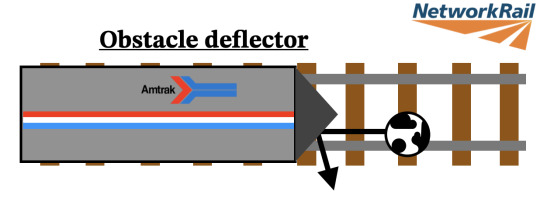
This device is known in America as a burgerizer, since it can provide an easy meal for the train crew –two of the five ingredients for a cheeseburger right on the front of the train, more if you're lucky– although since usually the obstacle is shoved off the track, the British name of "cowcatcher" is misleading, especially if you hit a truck instead. The burgerizer's physics can easily be calculated using conservation of momentum, but this involves vectors, and I don't want to deal with vectors right now is left as an excercise for the reader.
In the inelastic case, we note that the branch sticks to the front of the train. Since the inelastic case is more realistic (I will not justify this statement), this means that other things will also stick to the train. By the time the train reaches the end of the line, the mass of the things stuck to it may end up not being negligible (figure 6):
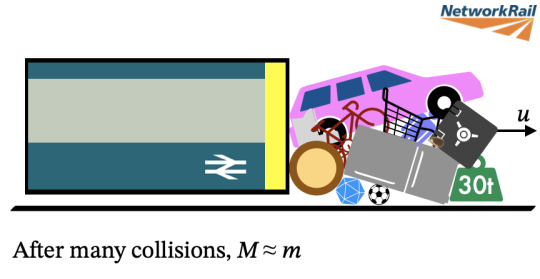
If the train is electric, this will strain the power grid and could lead to power cuts elsewhere as more energy is given to keep the train running at speed. If the train is diesel, it will be unable to provide constant power and could slow down (an electric train has access to every power station in the country if the need arises, a diesel train just has its onboard generator or motor AND a limited amount of fuel).
This mess is also difficult to clean up, and could damage the track as it is pushed along. Also, although we have been ignoring friction (since trains have very little rolling resistance) this pile of stuff will cause friction to be very noticeable, and could even obstruct the driver's visibility – potentially leading to more collisions.
–//–
Now that you have read through all of the calculations (or looked at the pictures and skipped the rest), you should have a thorough understanding of why we have to stop trains to clear things off the line, and can't just plow through them like in the movies. (I assume this happens in movies, I have not checked)
TL;DR: When the train hits a branch, either the branch goes flying towards you really quickly, at basically 1000km/hr, which is approximately the speed of sound; or it sticks to the front of the train and becomes part of a massive pile of things that gets in the way and slows down the train.
Finally:
I put the images together using the shapes in my computer's word processor (except the various rail logos); while the equations of motion under constant power are from this paper by Lloyd W. Taylor (published in 1930, I believe). Also thanks to @cosmos-dot-semicolon for peer reviewing this, any errors are not my fault.
#network rail#physics#trains#network rail essays#I spent way too much time on this you better appreciate it or else#I would not want to get hit by a tree branch moving at roughly mach 2#yes that is a spherical cow in figure 5#please do not leave refrigerators on the railway it is not good for them or the trains#and yes I did get the density of water wrong by a factor of 1000#I want to change it but I think it's funnier if I leave it as it is#a small branch probably is about 5kg though#but if I did use the correct density then the mass of the branch would be 5 tonnes and that very much isn't negligible#in the inelastic case the train's speed is actually reduced to 34m/s and in the elastic case it's reduced to 29m/s which is quite a lot#this also means that the speed of the branch in the elastic case is a thousand times higher at nearly 1.000.000km/hr#which is about 0.09266c so that is quite fast and it's a good thing the collision is inelastic since otherwise it could destroy a city#also I have decided that the train used in these calculations is the BR Class 000
7 notes
·
View notes
Text
when you think about it, Tanizaki’s ability is basically creating a irl real-time rendering engine
#been thinking for about half an hour about how that would work#because he says he transposes the surroundings to a digital realm#which is basically just code but to actually show what’s going on at least part of this digital realm has to be rendering engine like tech#also I’m being nitpicky but that would mean he doesn’t superimpose the surroundings on himself to disappear#but instead he skips his own render passes :P at least that would be more performant… it’s an ability so maybe he doesn’t need to worry#about performance… man if that’s the case I would go N on him to study the shit out of his ability#also how does he capture the surroundings? is it some kind of photogrammetry thing? gaussian splatting?#also he definitely needs some kind of physics engine as well otherwise collisions wouldn’t work#so he is more like a game engine#not tagging this with the rewatch tag as I’m just rambling about nerdy stuff#had to share this with the class because this will now be forever stuck in my head#sina’s rambling
10 notes
·
View notes
Text
Every outdoor wedding post Tyran2!Unicron gets divebombed by scorpions.
Enjoy your photos, jerks.
7 notes
·
View notes
Text
Okay, actually. No. I refuse to be miserable. As far as I’m considered, if no one is telling me I’m a failure to my face, then I ain’t one. Sure there are things going on right now that I don’t necessarily like, but that’s just life. I can work with it. I can wrestle advantages out of it if I try hard enough, even. Yeah that sorry excuse of a first term was godawful in retrospect but I learned a lot more from crashing and burning it spectacularly then I would have if I just scraped by like I usually do just to crash later down the line.
Beating back the demons armed to the teeth with spikes and steel, because the dark corners of my brain might have hands, but so do I. Never asked for an easier life, just the strength to endure through hardships. 🚶🏻
Besides I have 300 chapters worth of extremely accessible Golden Kamui now if I really need to cope harder at any opportunity. It’s just the right mix of bizarre and off the rails but grounded enough to not fully hold you hostage in la la escapism land.
Also I’m going to cut my hair shorter (it’s Kash length now, and too long for my liking) and draw and I am NOT letting my own mind stop me from doing that. Do not expect anything cool or grandiose or whatever if I draw I drew 🫡
#hyping myself up before bed#I have a bone to pick with the world and I’m gonna make it everyone’s problem#going to the public library all day tomorrow let’s hope I get some things done yeah?#l’etranger here I come#my art is mid and the content is cringe so therefore through collision physics I’m actually ascendant#ishkabibble
2 notes
·
View notes
Note
nishiki 12, 29?? 👀 i want to create chaos -squishy
sorry this was so late aghsdhahdh I always write too much and then have to whittle things down a bit so my thoughts are comprehensible
12. sexuality hc?
wellll I can pretty easily accept either gay or bi, but the way I interpret some of his actions/history/behavior/etc makes my personal view of him lean more towards gay than anything.
he’s never really shown real interest/attraction to women beyond using them as status symbols, and the whole thing with yumi made no sense (for him and kiryu both- you know my opinion on that plotpoint by now) and if I had to explain it rather than ignore it I’d have to say it was a weird half-assed excuse he came up with to explain some of his actions instead of addressing his actual issues at first.
but yeah I mean come on. have you SEEN reina. she’s cool and ridiculously pretty and goes above and beyond to care for him and others in general and etc etc etc, she was interested for YEARS and he never reciprocated At All. to me the Easiest explanation for that, whether he was aware of it or not (probably not), is just. him not really being into women. and possibly (at least at first) respecting reina enough to not fake her out and treat her like the girls that he had hang around him at the bars to look good to his superiors. in fact I think if he were to open up about all this to anyone it would be her (drunk, crying).
idk, a lot about him just sort of makes sense when you consider him to be gay and very repressed. boy’s got identity issues off the SHITS already, so it ties into that quite naturally.
29. how do you think they would be as a parent?
I think it depends on where he is in his recovery (mentally and physically) and the circumstances leading to that parenthood. similar to kiryu, I think he’d connect with orphans well and empathize with them strongly for obvious reasons. if he were to spend time in okinawa, perhaps to help him recover after The Incident, he’d be pretty closed off and prickly with everyone, kids included, at first– but honestly I think they’d help alot to get him to open up, regain trust, and enjoy life again. I don’t think he’d want to do it alone, or trust himself to, but he could end up fitting in pretty naturally as a guardian to them, and on the flip side, he’d benefit from having genuine care and lack of judgment through a tough recovery.
(I think he’d become quickly attached to riona above all else due to them sharing some feelings about their burn scars and how they look, and survivors guilt surrounding their parents)
#nishiki#asks#rambling#this was my only ask from this ask game and I was still ridiculously late agdhdshshshdhd#sorry squishy it’s not u it’s me………..#I have a LOT of thoughts about that situation of nishiki at morning glory during recovery and all that….a lot of thoughts#I mean shit having to cope with the burns is one thing but getting used to an entire limb missing potentially??? that’s a MAJOR lifestyle#change that everyone would end up helping with at least a little I think#I can just imagine him going to help the kids play baseball on the beach and realizing as soon as he picks up a bat that he doesn’t have#two hands to swing with anymore and that just sorta. breaking him#it’s reminding me of an oc of mine who lost an arm in a train/car collision and afterwards when he was having to return to everyday life#(especially before getting a prosthetic) he goes and tries to cook for his fiancé before he gets home and his fiancé ends up coming home to#find him on the floor on his knees in the kitchen with some stuff knocked over on the ground that he presumably tried to pull from the#cabinet and hold with his arm that isn’t there or something along those lines and he’s just. sobbing.#his fiancé ends up helping him out and holding things for him and all that but yeah point is I feel like nishiki would have alot of these#kinds of moments but Worse and More Often and more regarding his appearance than anything else#cause we know this boy’s already got some major self image issues#it’s very sweet to think about how he’d bond with riona and how she’d help him open up a bit more and come to terms with his physical state#long post
6 notes
·
View notes